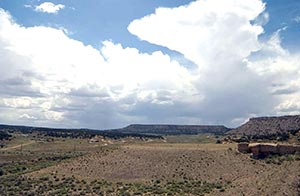Uranium workers to feds: Cut the red tape!
By Cindy Yurth
Tséyi' Bureau
SHIPROCK, July 23, 2009

(Times photo - Leigh T. Jimmie)
The site of the United Nuclear Corporation uranium mine on Red Water Pond Road today is silent and empty. On July 16, 1979, a dam holding radioactive waste broke releasing 94 million gallons of uranium tailings.
Cut the red tape and give us our money!
That's the message the Four Corners Uranium Committee will be taking to Washington in September on behalf of former uranium workers on the Navajo Nation.
Meeting with about 200 former uranium workers and family members July 17 at the Shiprock Chapter House, the committee told the crowd the provisions of the Department of Labor's "Part E" compensation are so tangled in red tape that they are essentially unworkable, and they want support for a lobbying trip to Congress.
Part E, passed in 2005 as the newest chapter in the government's efforts to compensate miners and millers who developed illnesses as a result of handling the uranium stockpiled by the feds during the Cold War, compensates former uranium workers for any wages they lost as a result of a uranium-caused disability.
They can get up to $250,000, but to qualify for that amount, a doctor must declare them 100 percent disabled, and they must present proof that they worked in a mine for more than $2 an hour.
"The federal government assumes you made $2 an hour in the 1950s," said committee Vice President Phillip Harrison, noting his research showed most miners earned between 60 and 90 cents per hour in those days.
In addition, argued committee member Earl Saltwater, the tests needed to prove disability - such as breathing tests and X-rays - can themselves contribute to a decline in health.
"These are people who have already been exposed to radiation all their lives, and you're going to X-ray them?" he said.
Committee member Bobby Charley said a DOL physician must review the report submitted by an IHS doctor, and the IHS doctor often won't stand by his findings if the other doctor challenges them.
"They won't advocate for us," he said. "They have a conflict of interest. They're federal employees."
The committee's solution?
"Today we still have a number of survivors," Charley said. "Pay them off! Pay them!"
The committee wants all uranium workers, not just those who are 100 percent disabled, to get a lump sum of $250,000, and if they have passed on, Saltwater argued, that amount should go to their spouse or surviving child (presently survivors are eligible for between $125,000 and $175,000).
Some people attending the meeting asked the committee to push their issues as well.
"I haven't heard anything about the post-1971 miners," said Tommy Reed of Shiprock, referring to the fact that the legislation covers only people who worked in the mines up to 1971.
Aaron Yazzie, president of Blue Gap Chapter, argued that compensation legislation - which currently covers workers and downwinders - should be expanded to folks who contracted uranium-related illnesses from drinking contaminated water. He noted that his chapter is more downstream than downwind, receiving runoff from several old uranium mines to the north.
"We can't even water our livestock in the ditches," he said.
Harrison said the committee is still working on its draft proposal to area congressional representatives, and there's still time to revise it.
"Congress and Washington are aware of the shortfalls in these laws," he said. "The word is that they want to do this right once and for all."

